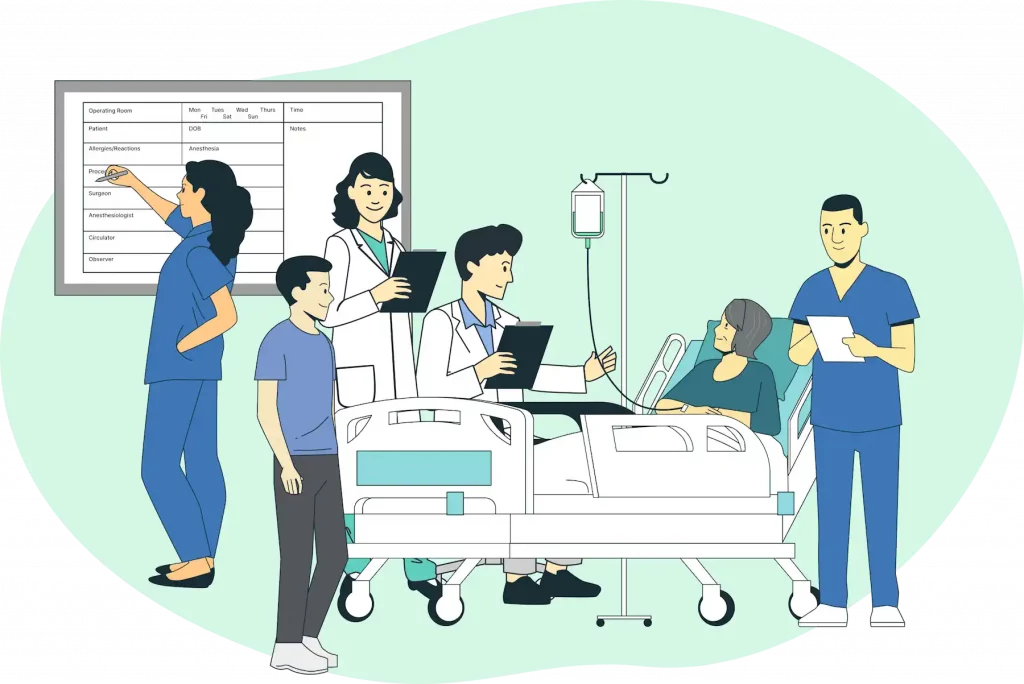Common Ground
What is Common Ground?
‘Common ground’ refers to the knowledge shared by individuals that lets them communicate meaningfully and complete interdependent tasks efficiently (Coiera, 2000, Kuziemsky and Varpio, 2010). Hospital units with weak common ground tend to have many physician teams passing transiently through the unit without a standard routine for communication or relationships, yet are trying to treat complex patients.
Impact of Weak Common Ground on Hospital Units
Hospital units with weak common ground tend to have many physician teams passing transiently through the unit without a standard routine for communication or relationships, yet are trying to treat complex patients. Professionals on units with weak common ground tend to use resources inefficiently, develop workarounds, struggle to find each other, and experience disrupted communication (Kuziemsky and Varpio, 2010).


Patient Involvement in Care Planning and Decision Making
Research has shown that patients want their care providers to be professional and communicate respectfully (van Dongen et al., 2017). Patients, particularly those chronically ill, appreciate having a role in their own care planning and decision making valuing the opportunity to engage in multidisciplinary team meetings (Cox et al., 2017, van Dongen et al., 2017). Barry and Edgman-Levitan (2012) highlight this noting the “Salzburg statement endorsing shared decision making, authored by representatives from 18 countries”. To be support interdisciplinary communication, many health systems have turned to health IT interventions to foster collaboration across the multi-disciplinary teams (Kurahashi et al., 2016). But this can cause other issues that fundamentally erode the development of common ground between stakeholders (Kuziemsky et al., 2011). The IT interventions themselves are predominantly workarounds to figuring out how to get interdisciplinary care teams to work and communicate effectively with each other and their patients.
The Limitations of Health IT
Safari rounds (O’Hare, 2008), a lack of standardized workflows and processes, and daily professional schedules that sometimes intersect but frequently compete, further complicate the delivery of coordinated care: patients, and indeed team members, are frequently out of the loop and unsure of what the big picture plan is. Consequently, as the patient record becomes the primary mechanism through which individual perspectives are shared, there develops a lack of common ground amongst not only the professional team but with the patient and their family (Kuziemsky and Varpio, 2010). This undermines the ability of the team to develop high-quality coordinated care and creates opportunities for risk states to go unnoticed, leading to incidents and adverse events.
Consequences of Poor Common Ground and Communication Inefficiencies
The Harvard Medical Practice Study (Brennan et al., 2004) evaluated adverse events to occur at a rate of 3.7% of hospitalizations. Adverse Drug Events (ADE) alone are estimated to occur at a rate of 1 in 100 medication administrations (Bates et al., 1999). (Kozer et al., 2002) reported prescription errors in 10.1% of charts reviewed. In Australia, Runciman et al. (2003) reported adverse drug events in 1% of hospital admissions and errors occurring in 15-20% of drug administrations of ward stock systems and 5-8% when individual patient systems are used.
In the Netherlands, Baines et al. (2015) reported a corrected and standardized adverse event rate of 5.7% and preventable adverse events of 1.4% of patient admissions. More recently in Ireland, Rafter et al (2017) reported an incidence rate of 10.3 adverse events per 100 admissions, with 70% considered preventable and 6.7% contributing to death.
While there are many potential reasons for these rates, communication is frequently identified as a contributing factor to error occurrence. Potential consequences of ineffective communication and failures are poor utilization of resources, interruptions, extended hospital stays, lower patient satisfaction and increased complications of care (Kuziemsky and Varpio, 2010, van Leijen-Zeelenberg et al., 2015). Agarwal et al. (2010) estimated that a 500-bed hospital loses over $4 million annually as a result of communication inefficiencies. Laurner (2013) estimated that ward rounds in the NHS in England consumed up to 30 000 h/day of staff time, costing up to £18 million yet remain despite being the ‘main production line’ of medicine remain ‘underappreciated, undervalues and underdeveloped.’


Strategies to Strengthen Common Ground
Strategies to counteract weak common ground include the creation of clinical microsystems, establishing a routine for communication exchanges to occur and relationships to be built. The Accountable Care Unit care model itself facilitates the development of common ground by creating the physical space and teamwork processes for it to occur. Geographically orienting physicians and allied health increases their time within a set unit, enabling a familiarity to build between the team members. Establishing communication processes, such as interdisciplinary bedside rounds, discharge huddles, or performance debriefs, creates requirements and opportunities for staff to interact with and support each other & the unit. Unit based interdisciplinary leadership provide opportunities for cross-discipline learning, coaching and mentoring.
Some of the most successful units we have worked with have had, for example, physicians or pharmacists mentoring nurses pursuing advanced degrees or nurse practitioner qualifications, or nurses working with physicians on quality improvements projects or research topics. If units can develop the structures needed to support the implementation of processes that source the optimal inputs, then outcomes will improve through shared plans, collaborative interdisciplinary work and improved communication through a shared common ground of understanding of the unit and its patients.
To explore these concepts further and discover more practical strategies for improving common ground and integrating other advanced teamwork concepts in your teams visit our Resources.